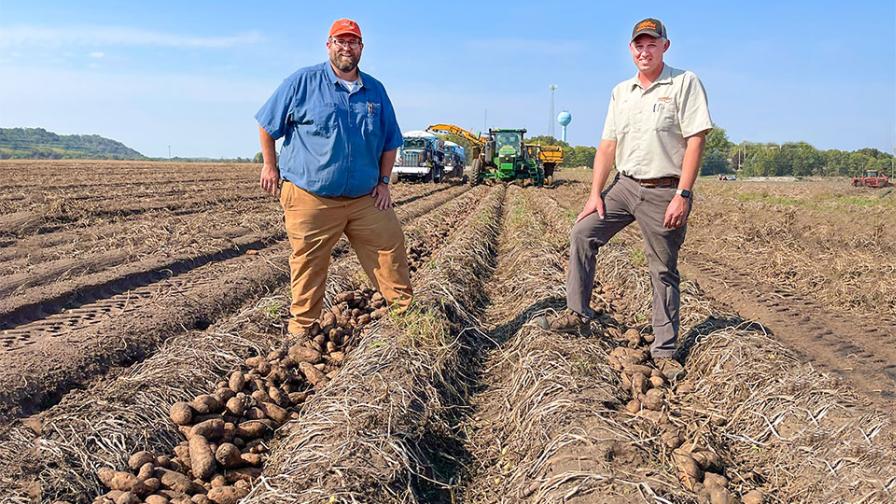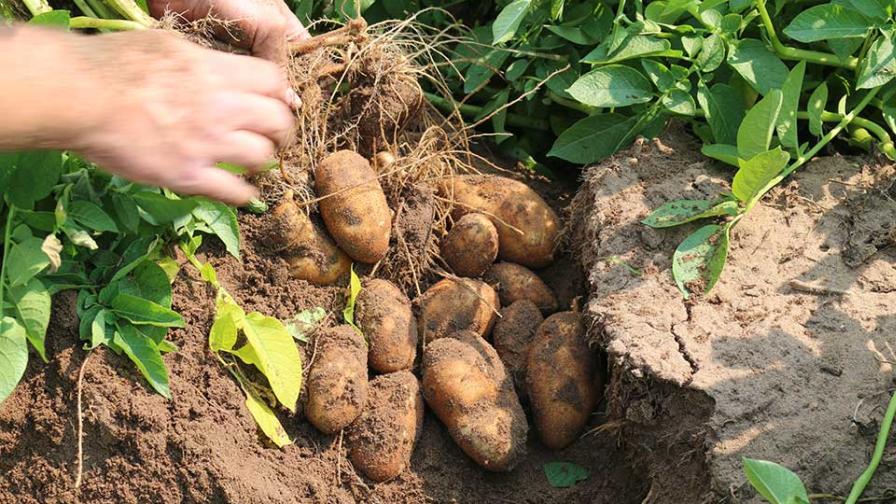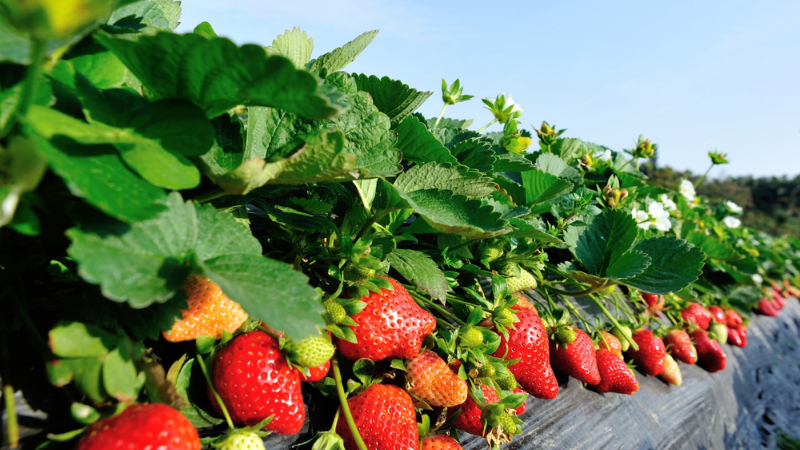Two Vegetable Farms Work Together With One Goal in Mind

Beau Hartline, Farm Manager for Alsum Farms and Produce, Inc. (left), and Joe Hartung, Farm Manager for Hartung Brothers, Inc., regularly update one another on soil health issues and pest control issues. That’s because they combine acreage at their Arena, WI, locations to get the crop rotation each needs.
Photo by Carol Miller
When Beau Hartline, Farm Manager for Alsum Farms and Produce, Inc., in Arena, WI, begins the yearly potato harvest for his farm, one of the first people he contacts is his colleague Joe Hartung, Farm Manager for Hartung Brothers, Inc. In fact, ever since Beau and Joe became farm managers at their respective locations, they have been communicating about their potato, corn, and bean crops from seed to harvest.
These aren’t just casual conversations, though. Alsum Farms and Hartung Brothers have developed a collaborative crop rotation plan across neighboring fields in the Wisconsin River Valley area. As a result, Hartline and Hartung work together throughout the year so both farms can reap the benefits of crop rotation as well as crop specialization.
The Rotation Plan
As Hartung explains, between the two farms, “we’ve got 5,700 irrigated acres. Of those, Alsum has about 1,500 acres, and Hartung Brothers owns about 3,500 irrigated acres and rents about another 700 acres.”
For each one-quarter of the total acreage, Hartline says, “it’s one year of potatoes and then one year of seed corn. And then the year after that, it’s typically some type of bean crop, and then one more year of seed corn, and then the rotation starts again with potatoes.”
The rotation plan is a win-win.
The Benefits
Each farm concentrates on what it grows best, taking advantage of years of specialized labor development, equipment investments, and a growing knowledge base.
And both farms benefit from the improved plant nutrition, soil structure, insect control, disease prevention, and water quality realized from rotating crops.
“We just seem to get that extra kick, yield, and quality by waiting the fourth year to rotate,” Hartline says. “If we grew only in our own fields, we’d be growing essentially 25% of what we’re growing every year.”

Alsum Farms and Produce grows fresh market potatoes and saw a strong increase in demand this past year.
Photo by Carol Miller
Three Keys to Making the Plan Work
Although the rotation plan seems simple, both Hartung and Hartline agree that the plan works because of good contracts, good communication, and a mutual sense of equity.
1. Good Contracts Make Good Neighbors
Hartung explains that the land is rented between the two farms, with formal contracts in place that detail the value of the acreage across the four-year rotation cycle. Additionally, the contracts specify which farm maintains and operates the irrigation equipment that both farms have in place.
“We manage 55 irrigators using a remote-control system,” Hartung says. “We are using each other’s equipment, and it’s in the contract that after the first turn of the irrigator, whoever’s growing the crop is responsible to maintain that irrigation equipment for the year, according to mutually agreed upon specifications.”
The formality prevents conflict, Hartline says.
“I strongly recommend having stuff in writing and being willing to negotiate on both sides,” he says.
2. Good Communication Is Essential
With good contracts as a foundation, communication between the two farm managers is what makes the rotation plan work from season to season, year to year.
Both Hartung and Hartline agree that they text or talk at least once a week, sometimes more often.
Both farms participate in harmonized GAP (Good Agricultural Practices) programs, Hartline explains, so they share information related to food safety protocols. They also talk about pesticide application, ground erosion, and irrigation equipment.
Hartung adds that they share all soil test or yield data.
“We share all the information we can,” Hartung says. “There’s no hesitation to figure out what’s needed and get that information to the other person.”
As one crop ends, the managers communicate so the other farm can make plans for the next season.
For example, as Alsum Farms was finishing their potato harvest at the south end of the field this year, Hartung Farms was bringing in their equipment to plant the winter cover crop at the north end of the field.
3. Doing What’s Right When Farming Is Tough
Even the best contracts and communication can’t keep the rain away. In 2018 and 2019, the Wisconsin River Valley experienced what Hartline calls “horrible flooding and rains that made it a nightmare to farm in the valley.” Both farms were affected.
Alsum Farms lost potatoes they could not harvest, and Hartung Brothers couldn’t plant corn the next spring on ground they had rented from Alsum Farms.
“There was a lot of give and take on that,” Hartline says. “We both tried to realize what it’s like to be in somebody else’s shoes. Hartung worked with us really well on that. The acres we couldn’t harvest, we didn’t have to pay for, and the following spring, the acres they couldn’t plant, they didn’t have to pay for.”

Irrigation booms stay with the field. Per the agreement, each farm turns over booms in good working order and whoever is using it bears the cost of keeping it well maintained.
Photo by Carol Miller
About the Two Farms
Alsum Farms and Produce, Inc., a grower-packer operation with about 2,700 acres in yearly potato production, grows several varieties of fresh market potatoes, including red, gold, and russet potatoes. Since the farm’s beginning in 1992, Alsum Farms has focused on potatoes and invested in specialized equipment to plant, hill, and harvest potatoes.
In the early 1990s, Larry Alsum, President and CEO of Alsum Farms and Produce, Inc., developed a working relationship with Dan and Don Hartung, owners of Hartung Brothers, Inc., whose land abuts Alsum Farms’ property in several places.
Hartung Brothers, Inc. farms on more than 4,000 acres in the Midwest and currently focuses on growing seed corn, beans, and cucumbers. Hartung Brothers also has invested in specialized equipment for planting, cultivating, and harvesting corn and beans.










